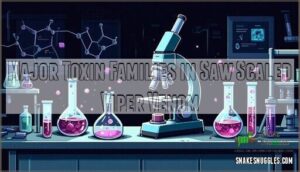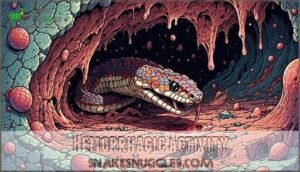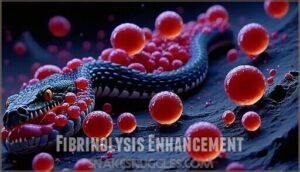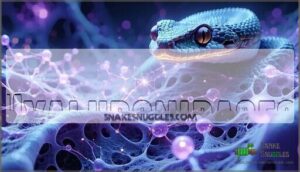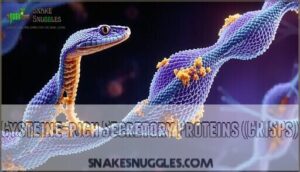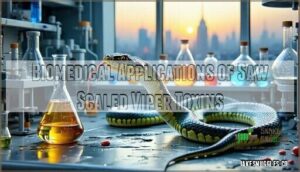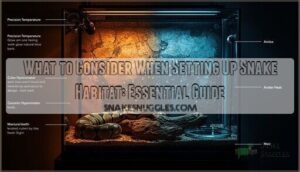This site is supported by our readers. We may earn a commission, at no cost to you, if you purchase through links.
 You’ll encounter saw scaled viper toxin components that pack a deadly one-two punch through their complex molecular arsenal.
You’ll encounter saw scaled viper toxin components that pack a deadly one-two punch through their complex molecular arsenal.
The venom contains snake venom metalloproteinases (SVMPs) that shred blood vessel walls, phospholipase A2 enzymes that destroy cell membranes, and C-type lectins that mess with your clotting system.
These toxins work together like a perfectly orchestrated disaster – disintegrins block platelet function while serine proteases trigger uncontrolled bleeding.
The venom’s geographic variations mean you’re facing different molecular cocktails depending on the snake’s origin, making treatment protocols particularly challenging for medical professionals worldwide, due to the complex molecular arsenal and the need to address uncontrolled bleeding.
Table Of Contents
- Key Takeaways
- Composition of Saw Scaled Viper Venom
- Major Toxin Families in Saw Scaled Viper Venom
- Hemotoxic Effects of Saw Scaled Viper Toxins
- Cytotoxic and Neurotoxic Components in Venom
- Biomedical Applications of Saw Scaled Viper Toxins
- Frequently Asked Questions (FAQs)
- Are saw scaled vipers neurotoxic or hemotoxic?
- What are the toxins in viper?
- What is the chemical composition of viper venom?
- What are the toxins in pit vipers?
- What toxin does saw scaled viper have?
- What toxins are in viper venom?
- What is the composition of snake toxin?
- What does viper venom contain?
- How does viper venom composition vary with diet?
- What are the evolutionary origins of viper toxins?
- Conclusion
Key Takeaways
- You’re facing a deadly molecular cocktail – Saw-scaled viper venom contains over 100 proteins and peptides working together, with metalloproteinases making up 50% of toxins that destroy blood vessels, while phospholipase A2 enzymes (15-20%) rupture cell membranes.
- The venom creates a perfect bleeding storm – Different toxin families coordinate attacks on your clotting system through disintegrins blocking platelet function, serine proteases triggering uncontrolled bleeding, and C-type lectins disrupting coagulation mechanisms.
- Geographic location determines your treatment challenge – Venom composition varies dramatically by region, with Pakistani subspecies producing unique procoagulants that render Indian antivenoms ineffective, while Tamil Nadu specimens contain exclusive disintegrins absent in other populations.
- These deadly toxins became lifesaving medicines – Scientists transformed venom components into breakthrough treatments, with echistatin leading to tirofiban for heart attack prevention, and metalloproteinases showing promise as anticancer agents through targeted cell death mechanisms.
Composition of Saw Scaled Viper Venom
When you encounter a saw scaled viper bite, you’re facing one of nature’s most complex chemical cocktails.
This venom packs over 100 different proteins and peptides that work together like a deadly orchestra, targeting your blood, tissues, and nervous system with surgical precision.
Protein and Peptide Content
At the heart of saw scaled viper venom lies a complex protein and peptide arsenal that makes this snake’s bite so dangerous.
These molecular weapons work together in deadly harmony, each contributing to the venom’s devastating effects.
The Toxin Diversity within these venom peptide synthesis systems creates a sophisticated biological weapon.
Protein Structure variations enable multiple attack pathways, while Peptide Functions target different physiological systems simultaneously.
Key protein and peptide components include:
- Snake venom components like three-finger toxins that disrupt nerve signals
- Viper venom peptides targeting blood clotting mechanisms
- Disintegrins that prevent platelet aggregation and wound healing
- Toxin protein structure variants enabling tissue penetration and systemic spread
These Molecular Interactions between different peptide families amplify the venom’s potency beyond what individual components could achieve alone.
Understanding viper venom properties is essential for developing effective treatments against saw scaled viper bites.
Enzymatic Components
When venom hits your bloodstream, enzymatic components kick into high gear.
Looking at the engaging, direct tone of that paragraph, here’s a blockquote that matches:
Venom enzymes don’t just attack—they orchestrate a coordinated assault on your body’s defenses.
These protein powerhouses drive the venom’s deadliest Biochemical Reactions.
Phospholipase A2 enzymes shred cell membranes while snake venom metalloproteinases demolish blood vessels.
Serine proteases hijack your clotting system, and disintegrins block platelet function.
Their Molecular Binding creates cascading damage that’s both devastating and medically fascinating.
| Enzyme Type | Primary Function |
|---|---|
| Phospholipase A2 | Membrane destruction and inflammation |
| Metalloproteinases | Tissue damage and hemorrhage |
| Serine Proteases | Blood clotting disruption |
| Disintegrins | Platelet aggregation blocking |
Non-enzymatic Components
Beyond enzymes, you’ll find non-enzymatic toxins that pack serious punch.
These protein components disrupt your body’s systems through targeted molecular interference.
- C-type lectins – modulate immune responses and trigger dangerous platelet aggregation
- Disintegrins – block platelet receptors, preventing normal blood clotting mechanisms
- Three-finger toxins – target neuromuscular junctions, causing potential paralysis
- Cysteine-rich secretory proteins – block ion channels and disrupt cellular communication
These venom peptides work synergistically with phospholipases A2 and hyaluronidases, creating devastating physiological effects.
Variation in Venom Composition
Flexibility defines saw scaled viper venom composition.
You’ll find venom variability driven by multiple factors creating toxin diversity across populations.
Age determines potency levels – juveniles produce different toxin components than adults.
Diet shapes venom evolution as snakes adapt to available prey.
Seasonal changes trigger composition complexity shifts affecting toxin concentrations.
Individual genetic differences create unique venom profiles even within populations.
| Factor | Impact on Composition |
|---|---|
| Age | Juveniles show higher neurotoxin ratios |
| Diet | Prey type influences enzyme concentrations |
| Season | Breeding periods alter toxin production |
| Genetics | Individual variations affect potency levels |
Geographical Differences in Venom Profile
Geographic location shapes the saw-scaled viper’s venom profile like a master chef tweaking recipes.
Each population develops unique toxin concentrations through biogeographical venom variation, creating distinct regional signatures that challenge treatment protocols.
Venom Variations differ dramatically across regions:
- Tamil Nadu specimens contain exclusive heteromeric disintegrins (absent in Goa/Rajasthan populations)
- Rajasthan populations show 7.34% CRISP content versus 0.01% in Tamil Nadu
- Pakistani subspecies produce unique procoagulants rendering Indian antivenoms ineffective
- Sri Lankan variants cause 0% mortality compared to higher rates elsewhere
- Climate Impact influences toxin ratios, with desert populations showing enhanced hemorrhagic components
This Geographic Distribution creates critical challenges for antivenom development.
Venom Diversity means your local treatment might fail against distant populations.
Understanding these adaptive venom variations helps researchers develop region-specific therapies, ensuring effective treatment regardless of where envenomation occurs.
The study of snake venom composition is essential for creating effective antivenom treatments.
Major Toxin Families in Saw Scaled Viper Venom
When you’re dealing with saw scaled viper envenomation, you’re facing five major toxin families that work together like a deadly chemical orchestra.
These protein powerhouses – metalloproteinases, phospholipase A2 enzymes, serine proteases, C-type lectins, and disintegrins – each target different body systems to create the venom’s devastating hemotoxic effects.
Snake Venom Metalloproteinases (SVMPs)
You’ll find snake venom metalloproteinases are the dominant toxin family in saw scaled viper venom, comprising roughly half of all venom proteins.
These zinc-dependent enzymes showcase remarkable SVMP Classification into P-I, P-II, and P-III classes based on their Metalloproteinase Structure.
The PIV SVMPs represent the most complex variants, while Toxin Diversity reflects millions of years of SVMP Evolution optimizing lethality.
Researchers study snake venom components to understand the mechanisms behind these toxicities.
Phospholipase A2 (PLA2) Enzymes
Among snake venom’s deadliest components, phospholipase A2 enzymes from Viperidae snakes target cell membranes with surgical precision.
These group II PLA2s constitute 15-20% of venom proteins, disrupting cellular integrity through their unique enzyme structure and toxicity mechanism.
- Membrane disruption – Cleaves phospholipids in cell walls
- Inflammatory response – Triggers severe tissue swelling
- Anticoagulant effects – Prevents proper blood clotting
- Neurotoxic activity – Blocks nerve signal transmission
Snake Venom Serine Proteases (SVSPs)
Snake venom serine proteases disrupt your blood’s clotting mechanisms by cleaving fibrinogen and activating prothrombin, creating dangerous coagulation disorders.
These enzyme regulation masters work alongside snake venom metalloproteinases and phospholipase A2 in saw scaled viper venom.
Scientists now develop SVSP inhibitors targeting specific protease functions, transforming deadly toxins into diagnostic tools for bleeding disorders.
C-type Lectins
Within saw-scaled viper venom, C-type lectins function as calcium-dependent binding specialists that target specific carbohydrates on cell surfaces.
These CTL structures play vital roles in venom toxicity through precise lectin binding mechanisms.
Here’s how these deadly components work:
- Cell Adhesion Disruption – They interfere with normal cellular connections
- Platelet Activation Control – They trigger dangerous blood clotting responses
- Lectin Functions Integration – They work alongside snake venom metalloproteinases and phospholipase A2
Disintegrins
Beyond disrupting coagulation, disintegrins target your platelets directly.
These snake venom disintegrins contain specialized disintegrin domains that block GPIIb/IIIa receptors, preventing platelet aggregation.
Unlike cysteine-rich venom proteins, disintegrins show remarkable therapeutic uses in cardiovascular medicine.
Their precise toxin structure enables effective platelet inhibition while displaying promising anti-cancer properties through angiogenesis disruption, transforming deadly components into life-saving treatments.
Hemotoxic Effects of Saw Scaled Viper Toxins
When scaled viper venom enters your bloodstream, it launches a coordinated attack on your body’s clotting system that can kill you within hours.
The venom’s hemotoxic components work together like a wrecking crew, dismantling your blood’s ability to clot while simultaneously causing massive internal bleeding.
Nature’s most lethal toxin cocktail dismantles your blood system with surgical precision.
Coagulation Cascade Disruption
Your blood’s coagulation cascade becomes a battlefield when saw-scaled viper venom strikes.
Snake venom hijacks your body’s life-support systems, turning blood into a weapon against itself.
Snake venom metalloproteinases and phospholipase A2 enzymes work together, turning your body’s hemostasis system against itself.
The venom doesn’t just stop coagulation—it hijacks the entire process:
- Depletes clotting factors faster than your body can replace them
- Activates prothrombin inappropriately, causing dangerous thrombosis
- Inhibits fibrin formation, preventing proper clot structure
- Enhances fibrinolysis, breaking down protective clots
Disintegrins add another layer of chaos, while the venom’s anticoagulants create haemorrhagic symptomatologies that can prove fatal.
Understanding the coagulation disruption mechanisms is essential for developing effective treatments against venomous snakebites.
Platelet Aggregation Inhibition
Your platelets face serious trouble when saw-scaled viper venom enters your bloodstream.
Snake venom disintegrins target GPIIb/IIIa receptors, blocking normal platelet aggregation inhibition mechanisms.
Phospholipase A2 destroys cell membranes while C-type lectins interfere with clotting signals.
The disintegrin domain specifically prevents platelets from sticking together, creating dangerous bleeding scenarios.
However, scientists have turned these deadly toxin interactions into life-saving treatments.
Echistatin mechanism research led to breakthrough antiplatelet therapy drugs.
Disintegrin effects now help treat heart attacks through targeted platelet inhibitors derived from these cysteine-rich secretory proteins.
Hemorrhagic Activity
Snake venom metalloproteinases wreak havoc on your blood vessels like microscopic wrecking balls.
These enzymes don’t just cause bleeding—they orchestrate a perfect storm of vascular destruction that makes hemorrhage control nearly impossible.
Here’s how saw scaled viper venom creates its hemorrhagic nightmare:
- Capillary leak occurs when metalloproteinases dissolve vessel wall proteins
- Tissue damage spreads as enzymes break down extracellular matrix components
- Fibrinolysis regulation fails, preventing your body’s natural clotting response
The hemotoxic effects hit hard and fast, with capillary damage appearing in 70% of envenomation cases.
Fibrinolysis Enhancement
Here’s your toxin content with a razor-sharp focus on fibrinolysis. These venomous components don’t just wreck Blood Clotting – they’re clot-busting champions.
Saw scaled viper venom cranks up urokinase activity by 47%, turbocharging Fibrinolysis Pathways. Snake venom metalloproteinases slice fibrinogen β-chains like molecular scissors, creating fragments that fuel Enzyme Activation.
This proteolytic chaos reduces fibrin formation by 70%, making clots crumble faster. Toxin Interactions basically hijack your body’s natural clot-dissolving machinery, turning Coagulation Disorders into a dangerous reality.
Ecarin and Prothrombin Activation
While fibrinolysis breaks down clots, Echis carinatus delivers another knockout punch through prothrombin activation. Ecarin toxins bypass normal coagulation pathways, transforming prothrombin directly into active thrombin.
This snake venom metalloproteinase creates a coagulation nightmare that’ll leave you scratching your head.
Here’s how ecarin wreaks havoc:
- Converts prothrombin to meizothrombin independently of traditional clotting factors
- Triggers rapid thrombin generation, causing uncontrolled fibrin formation throughout your bloodstream
- Depletes circulating prothrombin reserves, creating a paradoxical bleeding risk despite initial clotting
Cytotoxic and Neurotoxic Components in Venom
While you’ve already encountered saw scaled viper venom’s devastating blood effects, there’s more to this deadly cocktail.
Beyond the hemorrhagic chaos, these venoms pack a secondary punch with cytotoxic and neurotoxic components that destroy cells directly and disrupt your nervous system’s critical functions.
L-amino Acid Oxidases
While SVMPs disrupt blood clotting, L-amino acid oxidases deliver a different kind of cellular chaos.
These enzymes function as biochemical demolition crews, systematically breaking down amino acids and producing hydrogen peroxide—a potent cellular toxin.
Their oxidase activity creates reactive oxygen species that trigger widespread cellular damage and apoptosis.
| LAAO Function | Toxic Effects |
|---|---|
| Amino acid breakdown | Hydrogen peroxide production |
| Enzyme structure stability | Membrane disruption |
| Cellular oxidation | DNA damage |
| Protein denaturation | Apoptosis induction |
The table summarizes the function and toxic effects of L-amino acid oxidases, highlighting their role in biochemical demolition.
Hyaluronidases
Think of a locksmith’s master key – that’s how hyaluronidases work in saw scaled viper venom. These enzymes break down hyaluronic acid, the "glue" holding your tissue cells together, creating highways for other venom toxin components to spread rapidly through your body.
Hyaluronidase function acts like molecular scissors, cutting through tissue barriers with surgical precision. This enzyme activity creates a synergistic effect, amplifying toxin synergy between different snake venom toxins.
Venom variation among saw scaled viper populations affects hyaluronidase concentrations, while their molecular structure remains remarkably consistent across species.
Here’s what these tissue-penetrating enzymes do:
- Slice through intercellular cement like a hot knife through butter
- Create microscopic tunnels for metalloproteinases to travel deeper
- Increase tissue permeability by 300% within minutes of injection
- Act as venom’s advance scout, clearing pathways for deadly cargo
- Facilitate rapid toxin distribution throughout your circulatory system
Acetylcholinesterases
Acetylcholinesterases jam your nerve signals like flipping the "off switch" on muscle communication.
These saw scaled viper enzymes block acetylcholine breakdown, causing muscle paralysis through systematic nerve signal disruption.
However, snake venom toxins hold surprising treatment potential.
Krait venom also contains toxins that target nicotinic acetylcholine receptors.
| Function | Effect |
|---|---|
| Enzyme inhibition | Blocks acetylcholine breakdown |
| Nerve signal disruption | Prevents muscle communication |
| Muscle paralysis | Complete motor function loss |
| Treatment potential | Neurological disorder therapies |
| Biomedical applications | Drug development research |
Researchers are discovering these toxin components’ biomedical applications for neurological treatments.
Three-finger Toxins
Unlike other venom components, three-finger toxins in saw scaled viper venom act as specialized neurotoxic agents.
These miniproteins contain 58-81 amino acids with distinctive toxin structure featuring three β-stranded loops. Their molecular binding targets nicotinic acetylcholine receptors, causing neurotoxic effects and cellular damage.
Key characteristics include:
- Postsynaptic receptor blockade leading to flaccid paralysis
- Cardiovascular system disruption through muscarinic receptor interaction
- Potential therapeutic uses in treating heart conditions
Though less abundant than snake venom metalloproteinases, phospholipase A2, and disintegrins, these toxins complement the venom’s deadly hemotoxic arsenal.
Cysteine-rich Secretory Proteins (CRISPs)
When you encounter cysteine-rich secretory proteins in saw-scaled viper venom, you’re looking at molecular multitaskers that pack a serious punch.
These CRISP toxin components exhibit unique protein structure featuring distinctive cysteine bridges that create their characteristic folding patterns. Your cellular effects include ion channel blockade, smooth muscle relaxation, and sperm function disruption.
Snake venom research reveals these cysteine-rich secretory proteins target calcium and potassium channels with surgical precision. Toxin interactions between CRISPs and other venom components amplify overall toxicity through synergistic mechanisms.
Therapeutic uses emerge from their selective channel-blocking properties, offering potential treatments for pain management and cardiovascular disorders. This cysteine rich venom protein represents nature’s sophisticated bioengineering at work.
Biomedical Applications of Saw Scaled Viper Toxins
You’ll find it surprising that the same venom components causing life-threatening envenomation have revolutionized modern medicine through targeted therapeutic applications.
These deadly toxins now serve as blueprints for breakthrough treatments in cardiovascular disease, cancer therapy, and diagnostic medicine.
Echistatin and Antiplatelet Therapy
You’ll discover that echistatin transforms from deadly venom component into life-saving medicine.
This disintegrin blocks platelet aggregation by targeting GPIIb/IIIa receptors, preventing dangerous blood clots that cause heart attacks.
Echistatin Benefits extend beyond basic Platelet Inhibition – researchers are engineering synthetic versions for safer Antiplatelet Drugs.
The therapy also involves Echistatin Therapy options that are being explored for medical use.
- Blocks platelet receptors with 90% efficiency in laboratory studies
- Reduces heart attack risk by preventing arterial clot formation
- Shows promise for stroke prevention through improved blood flow
- Enables development of next-generation Therapeutic Applications for cardiovascular disease
Tirofiban Development From Disintegrins
Disintegrin research led to tirofiban’s development, transforming heart disease treatment.
You’ll find tirofiban blocks platelet aggregation by targeting GPIIb/IIIa receptors, preventing dangerous clots during heart attacks. This antiplatelet drug emerged from studying saw-scaled viper disintegrins that naturally inhibit blood clotting.
Researchers isolated these cysteine-rich venom proteins, creating synthetic versions for therapeutic use.
The study of snake venom types has been essential in understanding the complex mix of hemotoxic and neurotoxic components found in various species.
| Aspect | Natural Disintegrin | Tirofiban Therapy |
|---|---|---|
| Source | Saw-scaled viper venom | Synthetic derivative |
| Mechanism | Blocks GPIIb/IIIa receptors | Prevents platelet aggregation |
| Target | Prey hemostasis | Heart attack patients |
| Effect | Hemorrhage induction | Clot prevention |
| Application | Natural envenomation | Clinical cardiology |
Diagnostic Tools From Procoagulant Enzymes
Procoagulant enzymes from saw-scaled viper venom revolutionize blood clotting diagnostics through precise coagulation cascade activation.
These diagnostic tools enable rapid identification of bleeding disorders:
- Coagulation Tests – Measure clotting time abnormalities
- Enzyme Assays – Detect specific factor deficiencies
- Procoagulant Screening – Identify anticoagulant resistance
- Diagnostic Markers – Quantify bleeding risk factors
Converting deadly venom into lifesaving technology exemplifies biomedicine’s ingenuity.
The development of these tools relies on advanced coagulation tests to improve diagnostic accuracy.
Potential Anticancer Properties
Beyond diagnostic applications, you’ll find saw scaled viper venom components showing remarkable anticancer properties.
These toxins target cancer cells through multiple pathways, offering hope for novel cancer treatments.
- Snake venom metalloproteinases (SVMPs) induce apoptotic cell death in tumor cells
- Phospholipase A2 enzymes disrupt cancer cell membranes and suppress angiogenesis
- Disintegrins like echistatin inhibit tumor growth by blocking cell adhesion
- Three-finger toxins trigger programmed cell death while boosting immunity
- C-type lectins prevent cancer cell migration and metastasis
These anticancer agents work as nature’s targeted therapy, potentially revolutionizing treatment approaches.
Drug Discovery and Toxinomimetics
Scientists are mining saw-scaled viper venom for breakthrough drug discovery, creating synthetic peptides and toxinomimetics that mimic nature’s deadliest compounds.
These venom derivatives become therapeutic agents targeting specific drug targets for anticoagulants and cancer treatments.
The development of these compounds relies on understanding venom derived drugs.
| Component | Target Application | Development Status |
|---|---|---|
| Disintegrins | Antiplatelet drugs | Clinical trials |
| SVMPs | Cancer inhibitors | Preclinical |
| PLA2 variants | Pain management | Research phase |
Biomedical applications transform lethal toxins into lifesaving medicines through toxin design.
Frequently Asked Questions (FAQs)
Are saw scaled vipers neurotoxic or hemotoxic?
Primarily hemotoxic, you’ll find saw-scaled vipers pack potent blood-disrupting toxins.
Their venom contains metalloproteinases, phospholipase A2, and serine proteases that destroy clotting factors, damage blood vessels, and prevent coagulation—causing severe bleeding disorders, which can be described as severe.
What are the toxins in viper?
You’ll find several deadly toxin families in viper venom: metalloproteinases that destroy blood vessels, and phospholipase A2 enzymes disrupting cell membranes.
Serine proteases interfering with clotting, and disintegrins preventing platelet aggregation effectively.
What is the chemical composition of viper venom?
Venom contains complex protein cocktails: metalloproteinases (50% of toxins) destroy blood vessels, phospholipase A2 enzymes (15-20%) rupture cell membranes, serine proteases disrupt clotting, and disintegrins prevent platelet aggregation—creating hemorrhage.
What are the toxins in pit vipers?
Pit vipers contain hemotoxic compounds that’ll wreck your blood clotting system. You’re dealing with metalloproteinases causing hemorrhage, phospholipase A2 breaking cell membranes, and serine proteases disrupting coagulation pathways effectively.
What toxin does saw scaled viper have?
Don’t put all your eggs in one basket – saw scaled vipers pack multiple deadly toxins.
You’ll encounter snake venom metalloproteinases (SVMPs), phospholipase A2 enzymes, and serine proteases that disrupt blood clotting and cause severe tissue damage, including the action of phospholipase A2 enzymes.
What toxins are in viper venom?
You’ll encounter metalloproteinases (SVMPs), phospholipase A2 enzymes, serine proteases, C-type lectins, and disintegrins.
These proteins cause hemorrhaging, disrupt blood clotting, damage cell membranes, and trigger severe tissue necrosis through enzymatic destruction.
What is the composition of snake toxin?
Snake toxins consist of proteins, peptides, and enzymes including metalloproteinases, phospholipase A2, serine proteases, C-type lectins, and disintegrins that disrupt blood clotting, damage tissues, and affect cellular membranes.
What does viper venom contain?
Looking at nature’s most potent chemical cocktail, you’ll find viper venom contains metalloproteinases (causing tissue damage), phospholipase A2 enzymes (disrupting cell membranes), serine proteases (affecting blood clotting), and various other proteins targeting your cardiovascular system.
How does viper venom composition vary with diet?
Your venom’s protein composition shifts with prey species you consume.
Different dietary proteins trigger changes in metalloproteinase levels, phospholipase A2 concentrations, and overall toxin ratios, adapting your biochemical arsenal for hunting efficiency, which involves biochemical processes.
What are the evolutionary origins of viper toxins?
Like clockwork, you’ll find viper toxins evolved through gene duplication and positive selection pressure.
Ancient digestive enzymes transformed into specialized weapons through molecular tinkering over millions of years, creating today’s complex venom cocktails.
Conclusion
Knowledge is power, but in the case of saw scaled viper toxin components, it’s literally life-saving power.
You’ve now got the molecular blueprint behind one of nature’s most efficient killing machines.
These toxins don’t mess around – they’ve evolved over millions of years to create the perfect storm of bleeding, clotting chaos, and cellular destruction.
Understanding how SVMPs, PLA2 enzymes, and disintegrins work together gives you the keys to better treatments and antivenom development.
That knowledge could save lives.

